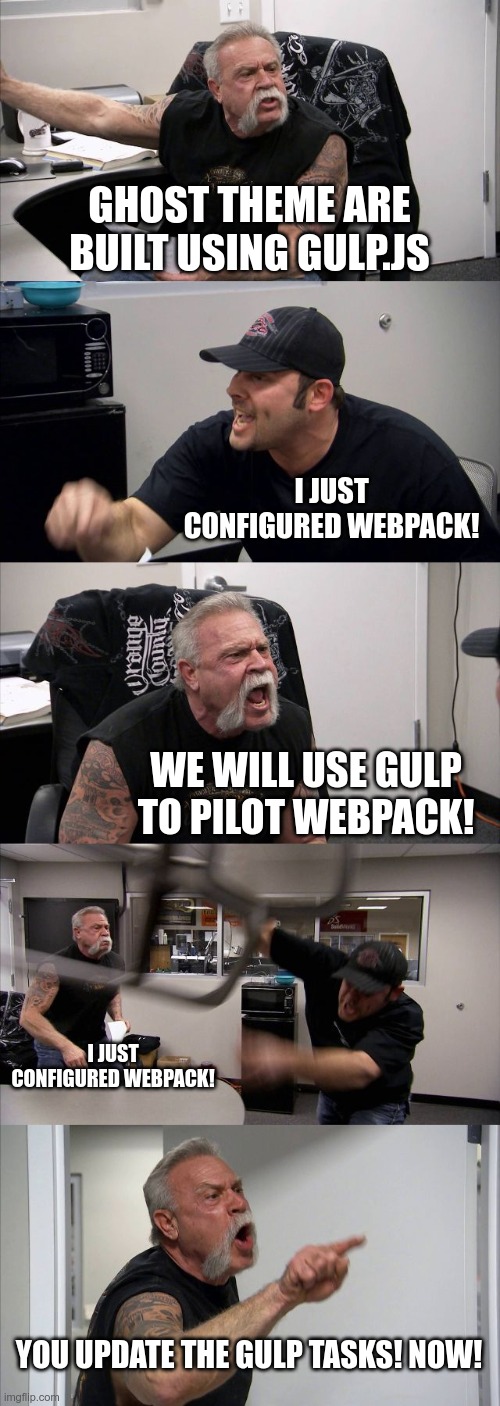Last week a client come to me and ask for a custom npm package with a standardized react component he can use in his three sites. No issue, I build the thing and start the integration.
- main website: ok
- documentation site: ok
- ghost blog: ... The problems start with the blog... Ghost blog theming is mainly editing handlebar files, zipping them, and uploading them to the blog.
The company behind ghost blog provides a sass solution for blogging, this means you won't be able to find how to install a local version easily but it is indeed quite easy.
npm install ghost-cli@latest -g
# create a local copy and start
mkdir someLocalBlogFolder
cd someLocalBlogFolder
ghost install local
ghost startYou can now connect to http://localhost:2368/ghost/#/site and set up a user.
And voila, first step done. We have a local copy! little voice: that's not what you had to do! none will pay for a local install!
Ok, to gain a little time we'll clone and edit the Casper theme which is the default ghost theme.
git clone [email protected]:TryGhost/Casper.git customCasper
cd customCasperCreate a navbar using Bulma
Let's install the basic libraries:
npm i -D react react-dom bulmaWe will build our react app in a folder called react
mkdir reactInside the react folder, we will create the react app entry point react/src/app.jsx.
import React from 'react';
import ReactDOM from 'react-dom';
import './app.scss';
import { NavbarContainer } from "./containers/NavbarContainer.jsx";
const navbarDomContainer = document.querySelector('#navbar');
ReactDOM.render(
(<NavbarContainer />),
navbarDomContainer
);Ok, technically we can just import bulma sass in the app.jsx file, but this way we will have an entry point to edit (if we want).
@charset "utf-8";
@import "bulma/bulma";
div#navbar {
z-index: 10000
}I know this is just the basic Bulma navbar example, it does not include the js to handle the burger menu (it will be covered in another post)
import React from 'react';
export const Navbar = () => (
<nav className="navbar" role="navigation" aria-label="main navigation">
<div className="navbar-brand">
<a className="navbar-item" href="https://bulma.io">
<img src="https://bulma.io/images/bulma-logo.png" width="112" height="28" />
</a>
<a role="button" className="navbar-burger burger" aria-label="menu" aria-expanded="false"
data-target="navbarBasicExample">
<span aria-hidden="true"></span>
<span aria-hidden="true"></span>
<span aria-hidden="true"></span>
</a>
</div>
<div id="navbarBasicExample" className="navbar-menu">
<div className="navbar-start">
<a className="navbar-item">
Home
</a>
<a className="navbar-item">
Documentation
</a>
<div className="navbar-item has-dropdown is-hoverable">
<a className="navbar-link">
More
</a>
<div className="navbar-dropdown">
<a className="navbar-item">
About
</a>
<a className="navbar-item">
Jobs
</a>
<a className="navbar-item">
Contact
</a>
<hr className="navbar-divider" />
<a className="navbar-item">
Report an issue
</a>
</div>
</div>
</div>
<div className="navbar-end">
<div className="navbar-item">
<div className="buttons">
<a className="button is-primary">
<strong>Sign up</strong>
</a>
<a className="button is-light">
Log in
</a>
</div>
</div>
</div>
</div>
</nav>
);Install webpack tooling with all the loaders we will need.
npm i -D webpack webpack-cli @babel/core babel-loader @babel/preset-env @babel/preset-react node-sass style-loader css-loader sass-loader At the theme root, we need to add a webpack configuration webpack.config.js file just like this one:
const path = require('path');
module.exports = {
entry: {
main: "./react/src/app.jsx",
},
module: {
rules: [
{
test: /\.jsx?$/,
exclude: /(node_modules|bower_components)/,
use: {
loader: 'babel-loader',
options: {
presets: ['@babel/env', '@babel/preset-react']
}
}
},
{
test: /\.css$/,
use: ["style-loader", "css-loader"],
},
{
test: /\.scss$/,
use: ["style-loader", "css-loader", "sass-loader"],
},
],
},
output: {
filename: "[name].bundle.js",
path: path.resolve(__dirname, "assets/built"),
},
};Cool, we can now bundle the react app using webpack.
little voice: but when i run npm run zip the react app is not built...
Ok then, we will need to install one last dependency.
npm i -D webpack-streamAdd a new webpack task in the file gulpfile.js and add the function to the build definition.
// ... more gulpfile ...
const webpackStream = require('webpack-stream');
// ... more gulpfile ...
function webpack(done) {
pump([
src('assets/built'),
webpackStream(require('./webpack.config.js')),
dest('assets/built')
], handleError(done));
}
// ... more gulpfile ...
// add the
const build = series(css, js, webpack);
// ... more gulpfile ...Oh yeah! we can now build everything the "right way".
npm run zipWait a second... We wrote a react app, we built the app.
Oh damned, we forgot to load the bundle in the main template.
Let's add the bundle to the main template: default.hbs
Let's rebuild and upload the built theme in the blog...
And voila, look at your blog and you have a bulma navbar.
